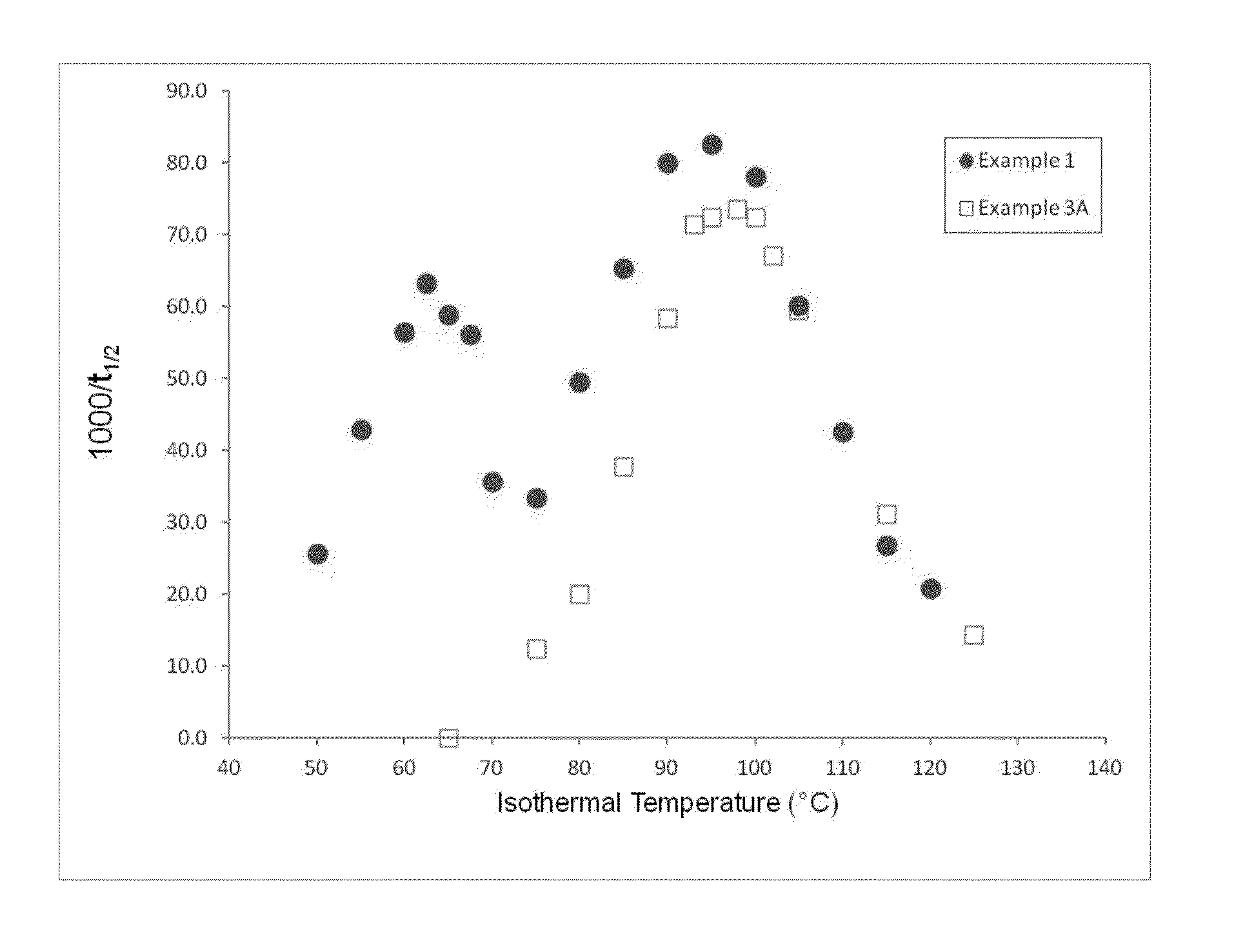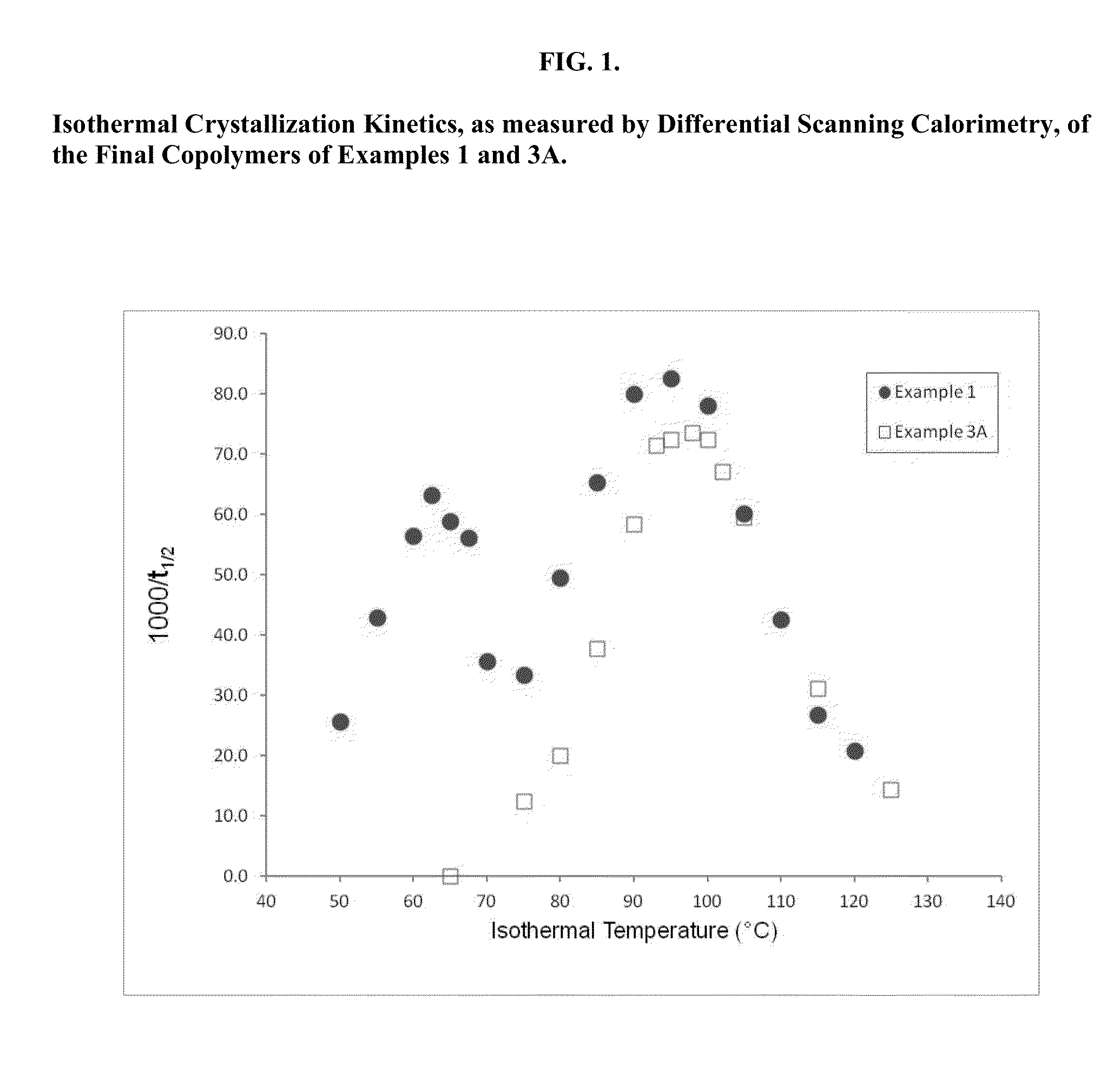Segmented, Semicrystalline Poly(Lactide-co-epsilon-Caprolactone) Absorbable Copolymers
- Summary
- Abstract
- Description
- Claims
- Application Information
AI Technical Summary
Benefits of technology
Problems solved by technology
Method used
Image
Examples
example 1
Synthesis of Segmented Block Copolymer Poly(L(−)-lactide-co-epsilon-caprolactone) at 64 / 36 by Mole [Initial Feed Charge of 70 / 30 Lac / Cap]
[0079]Using a conventional 2-gallon stainless steel oil-jacketed reactor equipped with agitation, 1,520 grams of epsilon-caprolactone and 1,571 grams of L(−)-lactide were added along with 3.37 grams of diethylene glycol and 2.34 mL of a 0.33M solution of stannous octoate in toluene. After the initial charge, a purging cycle with agitation at a rotational speed of 10 RPM in a downward direction was initiated. The reactor was evacuated to pressures less than 150 mTorr followed by the introduction of nitrogen gas. The cycle was repeated once again to ensure a dry atmosphere. At the end of the final nitrogen purge, the pressure was adjusted to be slightly above one atmosphere. The rotational speed of the agitator was reduced to 7 RPM in a downward direction. The vessel was heated by setting the oil controller at 190° C. When the batch temperature reach...
example 2a
Synthesis of Segmented Block Copolymer Poly(L(−)-lactide-co-epsilon-caprolactone) at 72 / 28 by Mole [Initial Feed Charge of 75 / 25 Lac / Cap]
[0085]Using a conventional 10-gallon stainless steel oil-jacketed reactor equipped with agitation, 5,221 grams of epsilon-caprolactone and 5,394 grams of L(−)-lactide were added along with 13.36 grams of diethylene glycol and 9.64 mL of a 0.33M solution of stannous octoate in toluene. After the initial charge, a purging cycle with agitation at a rotational speed of 10 RPM in a downward direction was initiated. The reactor was evacuated to pressures less than 150 mTorr followed by the introduction of nitrogen gas. The cycle was repeated once again to ensure a dry atmosphere. At the end of the final nitrogen purge, the pressure was adjusted to be slightly above one atmosphere. The rotational speed of the agitator was reduced to 7 RPM in a downward direction. The vessel was heated by setting the oil controller at 190° C. When the batch temperature rea...
example 2b
Synthesis of Segmented Block Copolymer Poly(L(−)-lactide-co-epsilon-caprolactone) at 74 / 26 by Mole [Initial Feed Charge of 75 / 25 Lac / Cap, Solid State Polymerization Final Treatment]
[0090]The smaller portion of the discharged resin, 6,900 grams, produced and described in Example 2A above was placed in a nitrogen purged oven and heated for 72 hours at 120° C. This solid state polymerization step was conducted in order to further increase the monomer conversion. After the solid state polymerization treatment, the resin was ground, sieved, and dried using the same procedures described earlier in Examples 1 and 2A.
[0091]The dried resin exhibited an inherent viscosity of 1.58 dL / g, as measured in hexafluoroisopropanol at 25° C. and at a concentration of 0.10 g / dL. Gel permeation chromatography analysis showed a weight average molecular weight of approximately 83,000 Daltons. Nuclear magnetic resonance analysis confirmed that the resin contained 74 mole percent polymerized L(−)-lactide and...
PUM
| Property | Measurement | Unit |
|---|---|---|
| Temperature | aaaaa | aaaaa |
| Temperature | aaaaa | aaaaa |
| Temperature | aaaaa | aaaaa |
Abstract
Description
Claims
Application Information
 Login to View More
Login to View More - R&D
- Intellectual Property
- Life Sciences
- Materials
- Tech Scout
- Unparalleled Data Quality
- Higher Quality Content
- 60% Fewer Hallucinations
Browse by: Latest US Patents, China's latest patents, Technical Efficacy Thesaurus, Application Domain, Technology Topic, Popular Technical Reports.
© 2025 PatSnap. All rights reserved.Legal|Privacy policy|Modern Slavery Act Transparency Statement|Sitemap|About US| Contact US: help@patsnap.com



